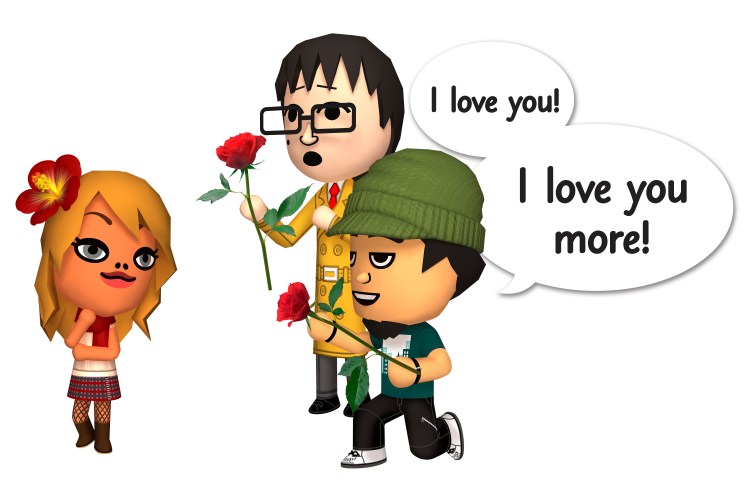Choice is a paradox. You would think that you could make people happier by giving them a lot of options, but Nintendo is finding out that the exact opposite is sometimes true — because while one of its next handheld games gives players a ton of ways to express themselves, it’s missing something important to many.
You cannot make homosexual characters in Tomodachi Life. The 3DS life simulator is due out June 6, and your character can fall in love, get married, and have children. The action centers around the drama that emerges as different Miis interact with one another. For example, I have former U.S. Attorney General Janet Reno, Don Draper from Mad Men, and Bill Murray as Mii characters on my 3DS, and I’m really hoping they get into a love triangle. That is possible. What isn’t possible is for a gay person to fall in love with and marry their partner’s Mii.
This has many people feeling excluded, which prompted a response from GLAAD, which is an advocacy group for people in the lesbian, gay, bisxeual, and transgender (LGBT) community.
“In purposefully limiting players’ relationship options, Nintendo is not only sending a hurtful message to many of its fans and consumers by excluding them, but also setting itself way behind the times,” GLAAD national spokesperson Wilson Cruz told GamesBeat. “It’s been over a decade since The Sims — the original ‘whimsical and quirky’ life simulator — allowed its users to marry any character they wanted, and many other mainstream and massively popular video games have followed their lead since. Nintendo should do the same.”
The Sims was publisher Electronic Arts’ take on everyday life. It enabled players to create characters and express themselves with almost no limit. The games are also massively popular, and EA will release a new one later this year.
Nintendo of America revealed yesterday, however, that it doesn’t plan to change Tomodachi Life.
“The ability for same-sex relationships to occur in the game was not part of the original game that launched in Japan, and that game is made up of the same code that was used to localize it for other regions outside of Japan,” a spokesperson for Nintendo told the Associated Press yesterday.
To get around that, gamers in Japan have long used a trick to create what appears like homosexual couples in Tomodachi Life by switching the gender of a Mii. Rumors spread earlier this year that Nintendo was calling that a “glitch” and was dispatching an update to “fix” it. These weren’t true.
“There actually was a misconception over what the issue in December was,” Nintendo of America product manager Bill Trinen told IGN in April. “There were two things that were going on at the time that essentially were grouped together [incorrectly] as one.”
In December, reports came out that Nintendo was updating a bug in Tomodachi Life that was causing a problem when players imported their characters from the original DS version. This coincided with the news that people were switching the genders of characters to create homosexual couples. This led to some conflation of the issues.
“So it was actually two separate things that got lumped together into one piece of confusion that resulted in people not quite understanding what had gone on.”
Gamers in Japan still have the option to switch genders of their characters to enable same-sex-looking couples. U.S. players will also have this capability.
That’s not enough for many people who feel like Nintendo is knowingly marginalizing a minority, but Nintendo says that wasn’t its intent.
“The relationship options in the game represent a playful alternate world rather than a real-life simulation,” a spokesperson for Nintendo said in a statement. “We hope that all of our fans will see that Tomodachi Life was intended to be a whimsical and quirky game, and that we were absolutely not trying to provide social commentary.”
Naturally, some people don’t see it that way. Nintendo fan Tye Marini recently posted a video online as part of an effort he is calling “Miiquality,” where he explains how Nintendo’s oversight affects him and his partner with whom he plans to wed.
“My only options are to marry some female Mii, to change the gender of either my Mii or my fiancé’s Mii — or other male Miis — or to completely avoid marriage altogether and miss out on the exclusive content that comes with it,” Marini said in the video.
Of course, this is a controversy that Nintendo hasn’t really dealt with before, and it is an example of the paradox of choice. For instance, in the Animal Crossing games, which are similar to Tomodachi Life, players can’t specifically set their character as homosexual, either. But Animal Crossing doesn’t give the players the option to express themselves sexually at all, so no one really notices what is missing. This is likely one of the reasons Nintendo overlooked including gay characters in the first place.
Nintendo also has a history of characters that have loosely defined genders that are also notable for how little anyone dwells on that fact. The Super Mario Bros. 2 miniboss Birdo, which shoots eggs from its face, has changed from male to female and back again over the years. The mushroom-topped Toad was androgynous for years before Nintendo introduced Toadette. And Yoshi is a male dinosaur that can lay eggs.
Oh, yeah — and then we have this:
VentureBeat's mission is to be a digital town square for technical decision-makers to gain knowledge about transformative enterprise technology and transact. Learn More

